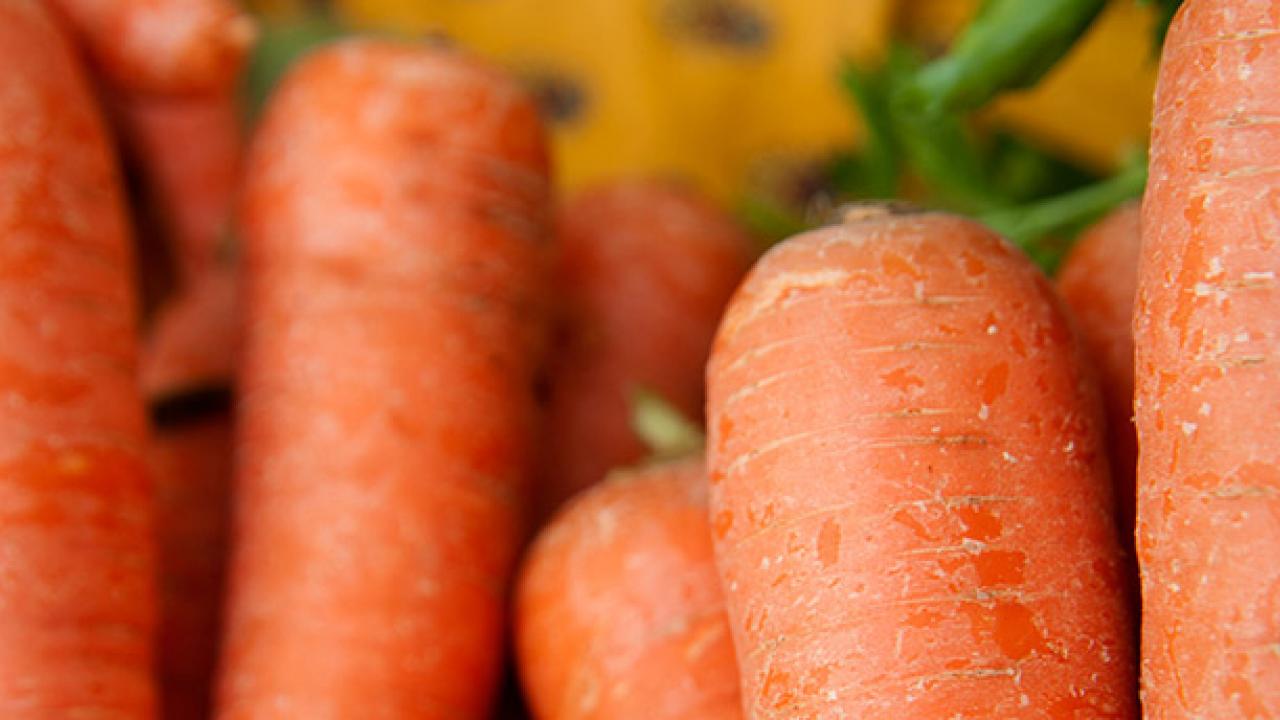Quick Summary
- New gene for color accumulation discovered
- Earliest domestication confirmed in Central Asia and Middle East
- Findings could help improve carrots and related crops
Sometimes, the evolutionary history of a species can be found in a fossil record. Other times, DNA and genetic fingerprints replace rocks and imprints.
That is the case for the carrot, the richest crop source of vitamin A in the American diet, whose full genetic code has been deciphered by a team led by the University of Wisconsin–Madison in collaboration with the University of California, Davis.
The study, published online today in the journal Nature Genetics, reveals how the carrot has been touched by domestication and breeding practices, as well as influenced by environmental and geologic change.
It also fills in a family tree of carrot relatives and reveals how carrots have become so good at accumulating carotenoids, the pigment compounds that give them their characteristic colors and nutritional strength.
“The carrot has a good reputation as a crop, and we know it’s a significant source of nutrition — vitamin A, in particular,” said lead researcher Phil Simon, a horticulture professor and U.S. Department of Agriculture geneticist at the University of Wisconsin–Madison. “Now, we have the chance to dig deeper, and it’s a nice addition to the toolbox for improving the crop.”
Knowledge gained from the study could also lead to the improvement of similar crops, such as parsnips and the yellow-fleshed cassava, a staple food throughout much of Africa.
“This was an important public-private project, and the genomic information has already been made available to assist in improving carrot traits such as enhanced levels of beta-carotene, drought tolerance and disease resistance,” said co-author Allen Van Deynze, director of research at UC Davis’ Seed Biotechnology Center. “Going forward, the genome will serve as the basis for molecular breeding of the carrot.”
Domestication dates back to Central Asia
Wild carrot seeds have been found in 3,000-to-5,000-year-old archaeological sites in Germany and Switzerland.
Cultivated carrots were first documented 1,100 years ago in Central Asia. Unlike wild carrots, which are white, those first domestic carrots were purple and yellow. The canonical orange carrot appeared in Europe in the 1500s, as shown in German and Spanish art of the time.
Color genetically linked to nutrients, not flavor
The new study reveals how the orange color occurs and which genes are involved, and also shows that carrot color is not genetically connected to flavor.
It is fortuitous that colored carrots became popular, because the pigments are what make carrots nutritious, and orange carrots are the most nutritious of all.
Nantes variety used for sequencing
The research team used the Nantes carrot — a bright orange variety named for a city in France — to assemble and analyze the full genetic sequence and peer into the vegetable’s evolution.
The carrot genome contains more than 32,000 genes arranged among nine chromosomes, which code for pest and disease resistance, colorful carotenoids and more. Carotenoids, like alpha- and beta-carotene, were first discovered in carrots.
The researchers uncovered features traced to distantly related plant species, from grapes and tomatoes to kiwi and potatoes. Carrots more recently split from lettuce, and they are in the same family as spice crops, like parsley and fennel.
The researchers also sequenced 35 different types of carrots to compare them to their wild ancestors. They showed that carrots were first domesticated in the Middle East and Central Asia, confirming the Vavilov Center of Diversity theory, which predicts cultivated plants arose from specific regions rather than randomly.
Carrots advanced as dinosaurs decline
The research team traced carrot evolution as far back as the dinosaurs. Sometime between the Cretaceous and Paleogene periods — roughly around the time dinosaurs went extinct — carrots, along with other plants of the era, picked up genetic advantages that allowed them to thrive.
The study confirmed that the “Y” gene is responsible for the difference between white carrots and yellow or orange carrots. It also identified a new, previously unknown gene that contributes to the accumulation of the colorful compounds. The newly discovered gene is actually a defect in a metabolic pathway that appears to be related to light sensing, the researchers said.
Plants derive their own nutrition through light sensing, or photosynthesis, but roots like carrots aren’t normally exposed to light and do not need photosynthetic pigments like carotenoids. The carrot has, in a sense, repurposed genes that plants usually use when growing in light.
Vitamin A essential to health
Global carrot consumption quadrupled between 1976 and 2013, and over the last 40 years, breeding has led to more nutritious carrots with the selection of ever more intensely orange crops. In fact, carrots have 50 percent more carotene today than they did in 1970.
While most Americans are not deficient in vitamin A, it is considered an essential nutrient, and deficiency is a problem in some U.S. communities and around the world. While the study may not solve the problem, it does highlight the opportunity carrots present to improve health and economic outcomes in other nations.
Collaborators and funding
In addition to Van Deynze and Simon, the study included co-authors from Michigan State University and around the world, including Poland, Spain, Italy, Turkey, China and Argentina.
The study was funded by the carrot industry and the following seed companies: Rijk Zwaan BV, Bejo BV, Monsanto Co., Nunhems USA, Takii Co., Vilmorin, Suminak and Carosem. Funds also were provided by the U.S. Department of Agriculture’s Agricultural Research Service, National Science Foundation, the Polish National Science Center and the Polish Ministry of Science and Higher Education.
Media Resources
Allen Van Deynze, UC Davis Seed Biotechnology Center, 530-304-9329, avandeynze@ucdavis.edu
Phil Simon, University of Wisconsin-Madison, 608-262-1948, psimon@wisc.edu
Kelly April Tyrrell, University of Wisconsin-Madison, 608-262-9772, kelly.tyrrell@wisc.edu
Pat Bailey, UC Davis News and Media Relations, 530-219-9640, pjbailey@ucdavis.edu
